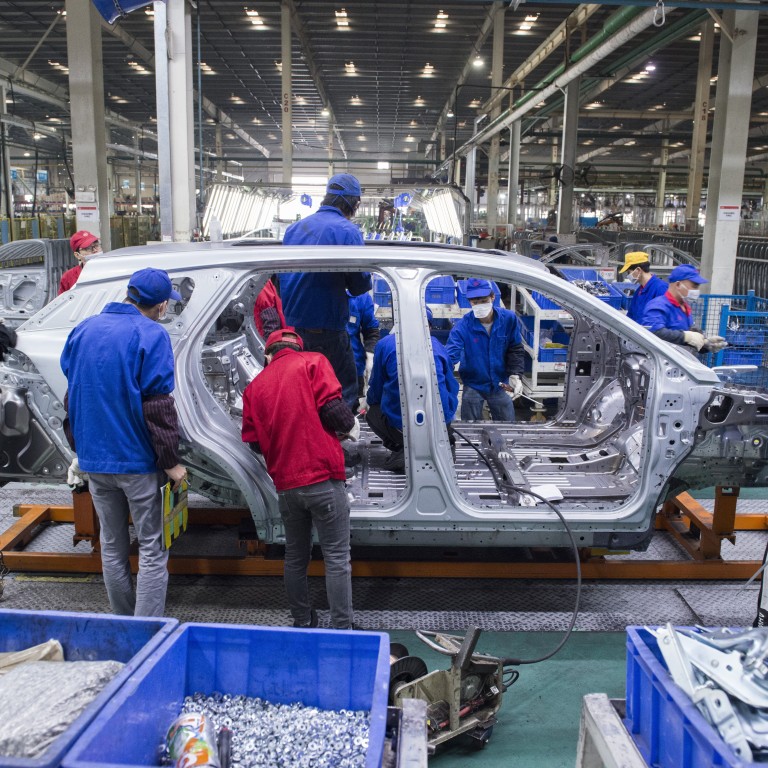
Subsidy cuts could sound the death knell for China’s cheap electric carmakers as entry-level vehicles face huge price rises
- Government subsidy cuts could force affordable electric-vehicle makers to raise prices beyond the reach of most entry-level buyers
- Electric cars priced below US$8,700 could soon cost over US$14,500, he estimates
Drastic cuts to government subsidies that have propped up China’s electric carmakers could create an existential crisis for those at the budget end of the scale.
Manufacturers who have been selling their vehicles for 60,000 yuan (US$8,715) or less will be forced to drastically raise their prices to cope with the withdrawal of financial support, according to Brian Gu, vice-chairman and president of Xpeng, a company seen by many as a challenger to Tesla.
Being unable to absorb cuts of up to 60 per cent in their subsidies as easily as high-end rivals, they will have to push up the price of their electric vehicles beyond the reach of many entry-level buyers, said Gu.
At that price consumers are likely to see higher quality cars as better value for money, creating a kind of filter process that weeds out the cheap, entry-level electric vehicles. Local brands have tended to be cheaper, with a much shorter range and less features than those offered by foreign carmakers such as Tesla and Nissan Motor.
“Players affected by the subsidies cut the most have to be the lower end players, as their products are not competitively designed, and those that are not able to reduce their costs of production and parts would see their margin affected the most,” said Gu. “Being unable to absorb some of these subsidy cuts themselves, these manufacturers would likely have to raise the selling price of electric vehicles to over 100,000 yuan, a level above which consumers are unlikely to seek entry-level cars, but look for functionality instead.”
Depending on the driving range, subsidies given to makers of new-energy vehicles were cut by 47 per cent to 60 per cent at the end of June. To qualify for any subsidy at all, battery-powered cars now need to have a range of at least 250km, up from 150km previously.
China has spent billions of dollars on subsidies to help companies like BYD and BAIC Motor achieve large-scale production of battery-powered vehicles.
They were aimed at encouraging wider use of green cars to reduce pollution and helping local manufacturers catch up with global leaders in the field in terms of technological standards, a vision etched into the ambitious “Made in China 2025” industrial strategy.
Now, by scaling back the subsidies, the government is hoping to spur more competitive innovation in the sector.
Gu did not say which particular companies he considered vulnerable to the subsidies cut. In April, BYD launched its e1 subcompact electric car that sells for 60,000 yuan after subsidies.
Gu expects growth in electric cars sales to drop this month, mainly because in June many consumers rushed to buy electric vehicles ahead of the subsidies cut implementation.
China’s overall car sales rose for the first time since May 2018 last month, according to the China Passenger Car Association. German luxury carmaker Porsche saw its sales in China grow by 28 per cent in the first half, compared to a year ago.
Sales of new-energy passenger vehicles shot up 38.7 per cent to 134,000 units compared to May, marking a 98.7 per cent increase from the same period last year. In the first half, sales rose 65.9 per cent, to 577,000 units.
In the longer term, Gu said there are actually some benefits from the subsidies cut. It might ease some cash-flow problems because manufacturers had been pre-funding the subsidies from their own books for an amount the government would only rebate two years after the sale of the vehicle.
Gu’s comments coincided with the launch of a 2020 edition of the company’s G3 all-electric sports-utility vehicle (SUV) this week. The model boasts a bigger driving range than its earlier version, at 520km on one charge compared to 365km, which it claims to be the longest range among compact battery-powered SUVs. Delivery will start in September, and prices will range from 143,800 to 196,800 yuan.
Tesla’s Chinese challenger Xpeng rolls out 10,000th SUV
Xpeng is holding a third round of fundraising, having raised US$925 million from two earlier rounds from investors including Alibaba Group Holding, IDG Capital, Hillhouse Capital, Xiaomi’s founder Lei Jun. Alibaba owns the South China Morning Post.
Gu said that while he is still aiming to complete the C-round funding this year, the US-China trade war has been “weighing on people’s minds when we talk about investing into China overall”.
“Over the past year we still see a lot of private equity firms raising big funds in the market. It is not as if the market is short of liquidity. But given the backdrop of the US-China trade war, investors do hesitate on deploying large amount into companies even though they have raised sizeable funds. Investors are getting more selective and cautious.”


